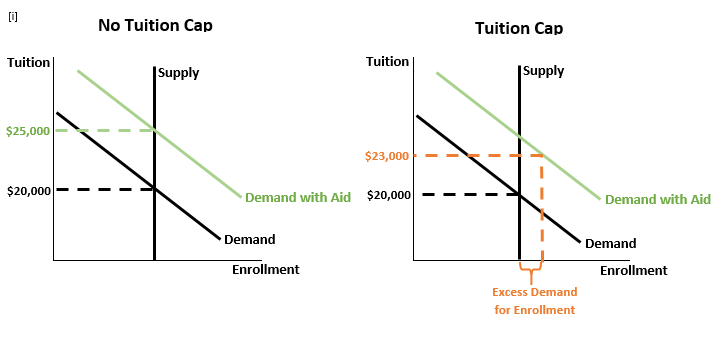- {{children.title}} {{currentYear}} {{children.title}}
- Manage Account
- Best 529 plans of 2024
- Your state's 529 plan
- Compare 529 plans

History of Student Loans: The Bennett Hypothesis
By Richard Pallardy
February 12, 2019
In a 1987 op-ed in the New York Times entitled “Our Greedy Colleges,” then-Education Secretary William J. Bennett ventured a theory that linked federal loan subsidies and the rising cost of tuition. His hypothesis has dominated debates surrounding the cost of postsecondary education for the past three decades.
In the piece, he claimed:
“If anything, increases in financial aid in recent years have enabled colleges and universities blithely to raise their tuitions, confident that Federal loan subsidies would help cushion the increase … Federal student aid policies do not cause college price inflation, but there is little doubt that they help make it possible.”
Wide-ranging research has attempted to ascertain the accuracy of that contention, with varied results. Some studies have found it to be broadly true, while others have found little-to-no correlation between increases in federal loan subsidies and rising tuition costs. Others still have come to more agnostic conclusions.
What is certain is that there is a correlation between the two phenomena. Rising tuition costs have mirrored increases in federal student loans, which in 1978 became available to all students regardless of income. The debate centers on whether this relationship is causal or incidental.
Defining the Bennett Hypothesis
Bennett’s original hypothesis defined the relationship between federal student aid and rising tuition costs rather narrowly—he specifically cited federal loan subsidies, as indicated in the above excerpt.
In 2013, in a New York Times interview , Bennett underscored the specific nature of his hypothesis, and reiterated that subsidies were unlikely to be the only cause of rising tuition:
“If the federal government gives money, tuition goes up. If the federal government doesn’t give money, it goes up … Federal student aid makes it easier for colleges to do what they’re going to do anyway, which is raise tuition.”
Those studying the validity of the hypothesis have frequently interpreted it more broadly, including other forms of student aid, such as Federal Pell Grants and private student loans, in their analyses. And some have ventured theories as to what the other causes might in fact be, whether in concert with, or to the exclusion of, increasing federal aid.
Thus, the Bennett hypothesis debate has come to encompass a wider range of factors than those contained in Bennett’s initial postulation.
Political Aspects
There is a political component to the debate over the degree to which federal subsidies have contributed to escalating tuition rates.
Political conservatives typically advocate for reduced government intervention and that includes student assistance. Bennett was Secretary of Education under Republican President Ronald Reagan and now hosts a conservative talk show. In 1981, at the beginning of his first term, Reagan initiated the first of several efforts to trim student aid programs, including subsidized loans and grants, with some success. Critics on the left were enraged.
Political liberals generally have more favorable attitudes toward federal educational subsidies. They tend to look for explanations of the rising cost of tuition elsewhere. One favored notion is that disinvestment in higher education at the state level has forced universities to raise cost of attendance in order to compensate. They argue that increases in financial aid enable students to enroll despite increases in costs.
Investigations by both private and government institutions have attempted to prove or disprove the Bennett hypothesis—and its extensions—using a variety of methodologies and data. Some notable efforts are detailed below.
In Support of the Hypothesis
- A 2014 study on institutions from five states by the non-partisan National Bureau of Economic Research found that for-profit institutions eligible for federal aid charged tuition that was 78% higher than tuition charged by for-profit institutions not eligible for federal aid.
- A 2015 study conducted by the Federal Reserve Bank of New York that studied increases in subsidized loans in comparison to rising tuition costs for 2007-09 found that the latter resulted in tuition hikes of up to 60 cents on the dollar. Unsubsidized loans led to tuition hikes of up to 15 cents on the dollar. The study also found that increased access to aid resulted in increasing college enrollment.
It also suggested restricting aid to students with demonstrated financial need and eliminating certain programs, such as graduate and Federal Parent PLUS loans.
They suggest that reduced federal aid to middle-income families would result in lower tuition. In their view, a greater emphasis on vocational training might effectively reduce the number of students at four-year institutions.
Disputing the Hypothesis
While some analysts have interpreted their data as supporting the Bennett hypothesis, the authors themselves felt that the phenomenon was unlikely to have persisted much beyond their period of study and that their conclusions did not support Bennett’s contentions.
- A 1998 report from the National Commission on the Cost of Higher Education investigated college costs from 1987-96. It analyzed published research on the relationship between federal aid and tuition costs and also commissioned two original analyses. Its findings did not support a causal relationship between federal loans and rising tuition costs, but it did acknowledge the existence of contradictory research and recommended further inquiry.
- A 2001 statistical analysis report from the National Center for Education Statistics that looked at data from 1988-98 found no relationship between state or federal aid subsidies and tuition costs.
- A 2003 study from the non-partisan National Bureau of Economic Research found no evidence that institutions jacked up tuition in response to increased federal or state subsidies at either public or private institutions. It did, however, find a relationship between institutional aid and rising tuition.
- A 2017 study from Seton Hall University investigated the effects on the higher lending limits allowed by Federal Grad PLUS loans — instituted in 2006 — on law school tuition. The study examined data from 2001-15. It found a negligible causal relationship between the availability of Federal Grad PLUS loans and rising tuition costs. A slight increase was noted at public institutions.
Lack of Consensus
Examinations of the literature on the Bennett hypothesis reveal a startling lack of consensus, as demonstrated by the studies described above.
Of course, this is to be expected to some extent given the variation in methodology, the different types of institutions studied, the inclusion or exclusion of federal aid programs, and the inconsistencies in the time periods studied.
Most studies, even those that support the hypothesis, acknowledge that in a complex economic system such as that of the United States, a single factor — federal aid — is unlikely to account for rising tuition costs in and of itself. Changes in available aid, economic fluctuations, and evolving student populations confound efforts to generalize the relationship between federal aid and tuition costs over time.
Flaws in Research about the Bennett Hypothesis
Even if the Bennett hypothesis is true, the lack of a strong correlation suggests that it depicts at best a weak relationship. The Bennett hypothesis may be true only for isolated subsets of higher education, such as for-profit colleges and universities.
After all, nobody rightfully believes that a $5,500 Federal Direct Stafford Loan limit and a $6,095 maximum Federal Pell Grant cause some colleges to charge as much as $75,000 a year. The mismatch in magnitude undermines the Bennett hypothesis.
Much of the research about the Bennett hypothesis is flawed because it looks for correlations between the total amount of financial aid and sticker prices, as opposed to correlations between changes in the amount of financial aid and changes in college prices. The former can never demonstrate a causal relationship and the latter appears to disprove it.
Consider that Federal Stafford loan limits did not increase from 1993 to 2007 or from 2008 to the present, yet college costs continued to increase during these periods. The maximum Federal Pell Grant remained unchanged at $2,300 from1989-90 to 1994-95, at $4,050 from 2003-04 to 2006-07 and at $5,550 from 2010-11 to 2012-13, yet college costs continued to increase. Some of these time periods overlap, meaning that there were no increases in federal grants and loans, yet college costs continued to increase at the same pace. Moreover, there was no spike in college costs when loan limits were increased in 2008 or when the maximum Federal Pell Grant jumped in 2009-10.
Some research about the Bennett hypothesis purports to find correlations with gross tuition rates or sticker prices. These results evaporate when retargeted at correlations with net tuition and net price. The correlations also disappear when re-examined at a granular level.
Other Possible Causes of Tuition Inflation
A range of other factors have been posited as explanations for tuition inflation.
Perhaps most prominently, loss of state funding has been blamed. A 2018 report found that state aid had been cut by some $7 billion in the last decade, resulting in tuition hikes. Another 2018 report found this to be true over a longer time period, from 1987 to 2017, though it was quick to caution that state funding was one factor among many.
Other observers have noted the ambiguous measures of institutional financial success in the education sector. Because these measures are often intangible — reputation, for example, is difficult to quantify — spending is not modulated as it might be in other enterprises.
Administrative, infrastructural, service, and regulatory costs are also likely contributors to tuition increases.
Thus, the most parsimonious conclusion is that the Bennett hypothesis accounts for, at most, a portion of the increasing cost of higher education. Nonetheless, the simplicity of the explanation and the plausibility of a supply and demand argument remain appealing to many and will likely persist in discussions of how to mitigate the problem.
Related Articles

Survey: New Roth IRA Benefit Likely to Impact 529 Plan Usage and Contributions

How Does Student Loan Interest Work?

Before you open a grandparent 529 account...

Your Guide to Vanguard 529 Plans
A good place to start:
See the best 529 plans, personalized for you

Unlock Printing
Already have an account? Log in
- Share full article
Advertisement
Supported by
Talking Head | William J. Bennett
Catching Up on the Bennett Hypothesis
By Samantha Stainburn
- Nov. 1, 2013
ON HIS nationally syndicated radio show, “Bill Bennett’s Morning in America,” William J. Bennett often advises students about college. Stories from callers burdened by student loans inspired his latest book, “Is College Worth It?,” written with David Wilezol. Dr. Bennett, 70, is not surprised that the cost of a four-year college has increased so much. In a 1987 opinion piece in The New York Times, which he wrote when he was President Reagan’s education secretary, he predicted it.
Your theory about the cost of college, which came to be known as the Bennett Hypothesis, seems more relevant today than when you formulated it more than a quarter century ago. Please explain it.
I postulated that the availability of a large amount of federal money was driving up tuition, and in the long run making it more difficult for poor students to go. It’s common sense. The more you subsidize something, the more you get of it. And almost every college chancellor or president I met felt that their obligation was to expand and create more departments, more centers and more graduate programs. In 1970, the bottom quartile economically constituted 12 percent of the student population. In 2010, the bottom quartile constituted 7.3 percent. Poor kids look at the tuition — $40,000, $50,000 a year — and say, “Forget it.”
Numerous studies have tested your theory. Some confirm it but others find no causal effect between more financial aid and higher tuition.
If the federal government gives money, tuition goes up. If the federal government doesn’t give money, it goes up. Now, I think the availability of federal funding drives it up more quickly and more surely. Federal student aid makes it easier for colleges to do what they’re going to do anyway, which is raise tuition. There’s more money available.

We are having trouble retrieving the article content.
Please enable JavaScript in your browser settings.
Thank you for your patience while we verify access. If you are in Reader mode please exit and log into your Times account, or subscribe for all of The Times.
Thank you for your patience while we verify access.
Already a subscriber? Log in .
Want all of The Times? Subscribe .
Bennett Hypothesis 2.0 (part 2)
Kauffman Researcher Josh Russell continues to explore the Bennett Hypothesis 2.0, focusing on school selectivity and the dynamic story of tuition increases.
In the last post we explored Andrew Gillen’s first expansion to the Bennett Hypothesis that not all aid is created equal. In this post we will explore his next two refinements – that selectivity, tuition caps, and price discrimination are important and that we cannot ignore the dynamic story surrounding tuition.
Selectivity, Tuition Caps, and Price Discrimination are Important
Gillen argues that tuition caps and price discrimination both weaken the link between aid and tuition by introducing an uncovered topic in the original Bennett hypothesis – selectivity. Tuition caps impose selectivity by preventing schools from raising tuition unchecked when government aid is given. Suppose a resource constrained school normally sets tuition costs at $20,000. If federal aid is given to every student in the amount of $5,000, tuition costs can now be raised to $25,000 and the number of students who are willing to pay will get in. But what happens if the state government puts a cap of $23,000 on tuition? Because of the federal aid, more students are willing to pay $23,000 to attend the school than can get in. [i] This imbalance allows schools to select only the most qualified candidates, thus increasing their selectivity. As Gillen points out though, many schools do not charge the highest possible tuition, meaning that under current circumstances, schools seem to value selectivity over revenue.
In many instances schools, especially private universities, selectivity charge students different amounts for tuition. These schools set a high base tuition and then, through scholarships and grants, lower the actual price paid for individual students. Imagine a school with a tuition of $30,000 that is trying to decide between two students: Student A who is low ability but willing to pay the full $30,000 tuition, and Student B who is high ability but only willing and able to pay $10,000. Who will this school choose? This is going to depend largely on the school climate. If the school wants to maximize revenue they will likely choose the low ability student, netting the full $30,000 tuition. If a school wants to maximize prestige they may offer the high achieving, poorer student $20,000 in aid to attend (i.e., losing $20,000 in revenue).
Don’t Ignore the Dynamic Story
Gillen argues that we can’t think of education funding as a static image. Previously I have written about Bowen’s Rule , and this rule comes into play when looking at the dynamic picture of school funding. In short, because schools want to achieve excellence and all the money they receive will go to this pursuit, schools will raise and spend all the money they can which leads to constantly increasing costs.
To illustrate the effect of Bowen’s Rule, let’s assume we have two schools. School A can only accept a set number of students and therefore will only increase tuition. School B, on the other hand, has the capacity to add more students, and therefore will only increase enrollment. What happens when grant aid is given to students in both schools? School A will raise tuition by the aid amount [ii] while School B will increase its attendance to offset the increased revenue [iii] .
But what does School A do with its increased revenue (from raising tuition)? As Bowen’s Rule says, it spends all of it to improve the school. These improvements could be new facilities, better professors, or new student programs, but – regardless of what School A buys – it will raise future costs. Buildings require maintenance, tenured faculty are hard to fire, and new programs require operating funding.
Furthermore, as we’ve explored in a previous post , colleges must also compete for prestige. If School A improves its campus, School B must find a way to compete. School B must build new facilities to entice students to come, it must raise pay to keep professors from leaving, and it must provide added programs to keep up. Even though School B isn’t raising tuition this year, it might need to next year to compete. Thus, even when schools try to survive with lower tuition, they may still need to increase tuition yearly to compete with other institutions.
How Do We Escape the Bennett Hypothesis 2.0?
Gillen’s short answer is that we can’t. He argues that the way we’ve set up competition in higher education drives the Bennett Hypothesis 2.0. Since colleges compete on relative standings, and not quality, no one school can look better without another looking worse. To escape, we must make schools pursue value over prestige, and the only way to do this is with better data. Getting comparable true cost of attendance and outcomes data for colleges is notoriously difficult.
While it can be difficult to obtain this data – largely due to price discrimination and incomplete survey data – there are other data we can use to determine a schools value. Making data around graduation rates, graduate school placement, debt ratios, and other data more accessible would go a long way in helping promote value over prestige and stopping the vicious cycle of the Bennett Hypothesis 2.0.
In case you’ve missed any posts in this series: Bennett Hypothesis: Does Student Aid Raise Tuition? Alternative Theories for Rising College Tuition: State Funding and Competition Alternative Theories for Rising College Tuition: Baumol’s Cost Disease and Bowen’s Rule Bennett Hypothesis 2.0 (part 1) Bennett Hypothesis 2.0 (part 2)

- Entrepreneurial Ecosystems Title Inflation and the Rise of the Startup Ninja April 28, 2015
- Real World Learning Bennett Hypothesis 2.0 (part 1) April 15, 2015
- Entrepreneurial Ecosystems Left Behind? The New Generation of Latino Entrepreneurs April 13, 2015

- Publications
- Get Involved

Does the Bennett Hypothesis Still Matter?
It’s been 30 years since then-Education Secretary William J. Bennett took to the pages of The New York Times to chide colleges for their “greedy” behavior. He decried the negative effect federal student aid seemed to have on tuition, namely, that it allowed universities to raise prices without feeling the consequences of reduced demand or lower-quality students.
To quote Bennett :
If anything, increases in financial aid in recent years have enabled colleges and universities blithely to raise their tuitions, confident that Federal loan subsidies would help cushion the increase. In 1978, subsidies became available to a greatly expanded number of students. In 1980, college tuitions began rising year after year at a rate that exceeded inflation. Federal student aid policies do not cause college price inflation, but there is little doubt that they help make it possible.
And, the problem has only grown since the 1980s. Colleges are still filling their coffers with federal money and increasing tuition each year to capture more of it. This phenomenon, called the Bennett Hypothesis, is now more than just an observation in an editorial. Scholars and pundits have amassed considerable evidence its favor.
The theory is really just common sense. If the government gives money to students to spend on education, then students will be able and willing to spend more on that product. Universities, knowing that the funds are available, raise tuition without worrying about whether students can afford it. An ugly cycle ensues.
And now, we’re seeing the effects. The price of college tuition and fees has risen 1,335 percent since 1978: much faster than inflation and faster even than medical care (704 percent) and housing (511 percent). Too many students go to college for the wrong reasons and too few graduate. Almost 4 million students dropped out of college with debt in 2015 and 2016. Student borrowing has soared to more than $1 trillion with many graduates (and non-graduates) unable to pay back their student loans.
In short, student borrowing is on an unsustainable path. Understanding the Bennett Hypothesis and examining the evidence is the first step in getting back on course.
With that goal in mind, I looked at the empirical evidence for a relationship between financial aid and tuition increases in a new research paper for the Martin Center, “The Bennett Hypothesis Turns 30” ( link here ). When Bennett first posited that federal aid enabled universities to increase tuition, there was little data to back him up. The first year in which the federal government began to expand aid and keep track of college costs was 1978. Now, with 40 years of data available, Bennett’s ideas can be tested.
In the paper, I examined empirical evidence from 25 articles published since 1987 in peer-reviewed journals or by respected economic research institutions. The studies focus on the empirical evidence for (and against) Bennett’s theory.
The studies I included in the report cover every type of postsecondary education: community colleges, for-profits, public universities, and private nonprofit universities. They also cover various kinds of financial aid: subsidized federal loans, PLUS loans to graduate students and parents, Pell grants, private loans, and even the Georgia HOPE Scholarship.
Taken as a whole, the scholarly research I examined suggests that federal student aid increases university tuition rates, perhaps by as much as 60 cents on the dollar. Of the 25 studies surveyed, a majority found some effect of federal subsidies on the price of higher education in at least one segment of the higher education market. The effect was most pronounced at for-profit institutions.
Based on my findings, I looked for policies that will slow the growth of university tuition and fees going forward. I found a few ways for the federal government and individual states to tackle the problem. Governments should enact policies that put downward pressure on tuition prices, focus aid on areas of true financial need, and end or minimize subsidies that artificially increase the demand for higher education or students’ tolerance for higher prices.
One suggestion is to make private student loans subject to bankruptcy laws. This would give private lenders incentives to tighten lending standards and decrease maximum loan amounts. Further policy recommendations are laid out in the paper.
In 2013, Bennett told The New York Times that he is more certain than ever that federal aid contributes to rising prices: “Now, I think the availability of federal funding drives [prices] up more quickly and more surely. Federal student aid makes it easier for colleges to do what they’re going to do anyway, which is raise tuition. There’s more money available.”
However, there is still work to be done. Further studies might discover the ideal maximum Pell grant award amount or federal loan limits to meet student needs without affecting tuition prices. Experimentation at universities and in states might reveal the best ways to put downward pressure on tuition. But in the meantime, we know enough to say that Bennett’s intuition was sound and to provide a blueprint for state and federal policy change.
Acting now to combat tuition inflation will improve the lives of thousands of individuals—students, parents, and taxpayers. It will also benefit the national economy. Student borrowers who previously “ boomeranged ” home to mom and dad and put off major life events such as marriage, homeownership, and children, will be able to fully participate in the economy. Young people will not be forced by crushing debt to consider only financial rewards when choosing a career.
“The Bennett Hypothesis Turns 30” provides the tools for citizens and decision makers to understand and improve college financing. It can be downloaded here .

Online-Learning Partners Can Help North Carolina Students
Jul 22, 2024 › Innovation
UNC Asheville Should Start Over
Jul 18, 2024 › Innovation
“Smoking-Gun” Data on North Carolina ACT Scores
Jun 6, 2024 › Academics
More Articles
The Invention of Recreation
Five movies for the twilight of western civilization, friday comic: finding purpose.
- 2024-08-16T07:00:16-0500 2024-08-16T06:30:50-0500 2024-08-16T06:00:03-0500
Feeding Mind, Pursuing Truth
Does the bennett hypothesis still matter.
- In Economics
- December 28, 2017

It’s been 30 years since then-Education Secretary William J. Bennett took to the pages of The New York Times to chide colleges for their “greedy” behavior. He decried the negative effect federal student aid seemed to have on tuition, namely, that it allowed universities to raise prices without feeling the consequences of reduced demand or lower-quality students.
To quote Bennett :
If anything, increases in financial aid in recent years have enabled colleges and universities blithely to raise their tuitions, confident that Federal loan subsidies would help cushion the increase. In 1978, subsidies became available to a greatly expanded number of students. In 1980, college tuitions began rising year after year at a rate that exceeded inflation. Federal student aid policies do not cause college price inflation, but there is little doubt that they help make it possible.
And, the problem has only grown since the 1980s. Colleges are still filling their coffers with federal money and increasing tuition each year to capture more of it. This phenomenon, called the Bennett Hypothesis, is now more than just an observation in an editorial. Scholars and pundits have amassed considerable evidence in its favor.
The theory is really just common sense. If the government gives money to students to spend on education, then students will be able and willing to spend more on that product. Universities, knowing that the funds are available, raise tuition without worrying about whether students can afford it. An ugly cycle ensues.
And now, we’re seeing the effects. The price of college tuition and fees has risen 1,335 percent since 1978: much faster than inflation and faster even than medical care (704 percent) and housing (511 percent). Too many students go to college for the wrong reasons and too few graduate. Almost 4 million students dropped out of college with debt in 2015 and 2016. Student borrowing has soared to more than $1 trillion with many graduates (and non-graduates) unable to pay back their student loans.
In short, student borrowing is on an unsustainable path. Understanding the Bennett Hypothesis and examining the evidence is the first step in getting back on course.
With that goal in mind, I looked at the empirical evidence for a relationship between financial aid and tuition increases in a new research paper for the Martin Center, “The Bennett Hypothesis Turns 30” ( link here ). When Bennett first posited that federal aid enabled universities to increase tuition, there was little data to back him up. The first year in which the federal government began to expand aid and keep track of college costs was 1978. Now, with 40 years of data available, Bennett’s ideas can be tested.
In the paper, I examined empirical evidence from 25 articles published since 1987 in peer-reviewed journals or by respected economic research institutions. The studies focus on the empirical evidence for (and against) Bennett’s theory.
The studies I included in the report cover every type of postsecondary education: community colleges, for-profits, public universities, and private nonprofit universities. They also cover various kinds of financial aid: subsidized federal loans, PLUS loans to graduate students and parents, Pell grants, private loans, and even the Georgia HOPE Scholarship.
Taken as a whole, the scholarly research I examined suggests that federal student aid increases university tuition rates, perhaps by as much as 60 cents on the dollar. Of the 25 studies surveyed, a majority found some effect of federal subsidies on the price of higher education in at least one segment of the higher education market. The effect was most pronounced at for-profit institutions.
Based on my findings, I looked for policies that will slow the growth of university tuition and fees going forward. I found a few ways for the federal government and individual states to tackle the problem. Governments should enact policies that put downward pressure on tuition prices, focus aid on areas of true financial need, and end or minimize subsidies that artificially increase the demand for higher education or students’ tolerance for higher prices.
One suggestion is to make private student loans subject to bankruptcy laws. This would give private lenders incentives to tighten lending standards and decrease maximum loan amounts. Further policy recommendations are laid out in the paper.
In 2013, Bennett told The New York Times that he is more certain than ever that federal aid contributes to rising prices: “Now, I think the availability of federal funding drives [prices] up more quickly and more surely. Federal student aid makes it easier for colleges to do what they’re going to do anyway, which is raise tuition. There’s more money available.”
However, there is still work to be done. Further studies might discover the ideal maximum Pell grant award amount or federal loan limits to meet student needs without affecting tuition prices. Experimentation at universities and in states might reveal the best ways to put downward pressure on tuition. But in the meantime, we know enough to say that Bennett’s intuition was sound and to provide a blueprint for state and federal policy change.
Acting now to combat tuition inflation will improve the lives of thousands of individuals—students, parents, and taxpayers. It will also benefit the national economy. Student borrowers who previously “ boomeranged ” home to mom and dad and put off major life events such as marriage, homeownership, and children, will be able to fully participate in the economy. Young people will not be forced by crushing debt to consider only financial rewards when choosing a career.
“The Bennett Hypothesis Turns 30” provides the tools for citizens and decision makers to understand and improve college financing. It can be downloaded here .
This article has been republished with permission from The James G. Martin Center for Academic Renewal.
[Image Credit: David Shankbone (cropped) (CC BY 3.0) ]
Jenna Robinson
Leave a Comment
Your email address will not be published. Required fields are marked with *

- Culture , Featured
- August 16, 2024

- Entertainment , Western Civilization

- Entertainment

C.S. Lewis on the True, the Good, and the Beautiful
- Featured , Literature , MomThink
- August 15, 2024

Why Doing Nothing Changes Everything

Why Corporate America's Retreat From Social Activism Is Good for Everyone
- Economics , Culture

Most Read from past 24 hours
Most Read from past 7 days
Most Read from past 30 days
Friday Comic: Wants and Needs
- August 9, 2024
Most Read of All Time
How Music Training Speeds Up Brain Development In Children
- August 29, 2016
Reading to Your Child: This is why it's so important
- May 9, 2016

Special Interests Could Be Delaying a COVID-19 Vaccine
- June 17, 2020
AI: What It Means for Our Democracy
- Politics , Culture , Featured
- August 12, 2024
Lincoln’s Last Hope: A Political Religion
- History , Featured , Politics , Religion
- July 29, 2024
A Fond Farewell From Annie
- From the Editorial Board
- October 24, 2022
The Tragic Decline of Music Literacy (and Quality)
- August 16, 2018
Yellowstone: The Hidden Propaganda in Television and Movies
- February 23, 2023
Latest Posts

Frequent Contributors

Kurt Mahlburg
Contributor.

Walker Larson

Cadence McManimon

Adam De Gree

Heather Carson

Rebekah Bills

Nate Rudquist

Simon Maass

Annie Scaife
About intellectual takeout.
We provide a platform for rational discourse on all aspects of culture, inspiring action that leads to the restoration of a healthy and vibrant America.
Get In Touch With Us
Stay in the know.
Sign up for our Daily Digest email newsletter to receive intellectually engaging content and updates from our organization straight to your inbox.
Contact Info
Physical address.
8011 34TH Ave S Ste C-26 Bloomington, MN 55425
Mailing Address
PO Box 1244 Minnetonka, MN 55345
(612) 440-0205

More From Forbes
The bennett hypothesis confirmed -- again.
- Share to Facebook
- Share to Twitter
- Share to Linkedin
It was nice to return from a week of teaching in Europe to read in the Wall Street Journal that something I had written nearly a decade ago was “prescient.” Specifically, I claimed then that for every one dollar of federal student aid disbursed, universities raise their tuition fees by 35 cents, capturing a goodly portion of the assistance designed to help students – confirming what Education Secretary Bill Bennett said more than a generation ago.
Now a new staff report by David Lucca, Taylor Nadauld, and Karen Shen of the New York Federal Reserve Bank goes even further, suggesting the average tuition increase associated with expansion of student loans is much larger – in some cases 65 cents per dollar, and that the impact is considerable (55 cents per dollar) with Pell Grants as well. The major beneficiaries of these federal so-called “student” financial assistance programs are the universities, not students. Following the money, we see a huge portion of the increment financial largess has gone to fund increased non-teaching staff, super salaries for a small but meaningful portion of the senior faculty and administration, et cetera.
Moreover, the Fed report shows that the schools benefiting the most from the tuition hikes associated with federal aid are the elite, selective private institutions. The results confirm what I have been saying with increasing frequency: federal financial aid programs are leading to greater educational inequality in America, where the cognitively blessed and economically advantaged have ever growing superiority of educational opportunity, able to attend the “great” private schools as opposed to merely adequate public institutions. Few of the top 50 on the US News or Forbes rankings these days are public universities.
A year or so ago, I asked the question, “What would tuition be at American universities today if it grew at the rate after 1978 equal to the tuition growth prior to that date? Before 1978, federal aid programs were largely non-existent or quantitatively much smaller than today. Tuition fees today would be over 40 percent lower if pre 1978 fee growth had been maintained. Typical state schools would have in-state sticker prices of $5,000 or so, with the more prestigious ones perhaps charging $7,000. The top private schools would charge perhaps $25,000, with a typical private tuition fee being closer to $15,000. The ratio of tuition fees to family income has risen significantly in the last 35-40 years, but would not have in this counterfactual world I am describing – one without a big increase in student loan and grant programs by the federal government.
All of this came home to me last week teaching in the Czech Republic. I was at the CEVRO Institut of Prague, a very fine small accredited school offering graduate instruction in law, economics, and politics. Also teaching with me was a professor at the similarly small Anglo American University of Prague. Both schools were totally private, not receiving any government aid. What were the tuition fees? At CEVRO, a bit over $3,000 a year. At Anglo-American, about $5,000. Students are eligible for government provided vouchers allowing them to rent housing cheaply – but no loan or grant programs.
As I jokingly said of the rector at CEVRO, Josef Sima, he is not only the chief executive officer, but also the provost, the chief financial officer, and dean of students. These schools are no nonsense educational institutions, offering high quality instruction in clean, nice classrooms in central locations – but without football teams, diversity coordinators, affirmative action police, trigger warnings, faculty teaching courses mainly in their obscure academic specialization while writing even more obscure papers, et cetera. Faculty are paid to teach – period, although most have Ph.D degrees from good institutions.
How to extricate ourselves from the mess an earlier generation of well-intended but hopelessly wrong politicians created? With difficulty. The solution of President Obama, Elizabeth Warren and other progressives is: more of the same – bigger Pell Grants, more loan forgiveness, lower interest rates on loans, et cetera. In other words, an open invitation for colleges to expand their rent-seeking through accelerating the academic arms race.
My solution: begin to significantly downsize these programs. End the PLUS program (loans to parents of students) and tuition tax credits. Put sharp time and financial eligibility limits on Pell Grants. Curtail seemingly endless provision of aid for graduate and professional education. Provide a legal environment that could lead to private Income Share Agreements – students selling equity, rather than bonds (the equivalent of student loans) in themselves. Make colleges have skin in the game – make them share the pain from massive loan delinquencies, et cetera. Put on minimal performance standards for aid eligibility.
The Fed study suggests the federal programs have had some positive enrollment effects, but not as dramatic as the price effects (the law of demand at work – as tuition fees rise, some students are turned off by college). Drastically reducing them would thus depress enrollments slightly, leading to more creative destruction in American higher education – underperforming institutions disappearing. It would help somewhat reduce the mismatch between jobs available and the skills of college graduates. In short, it would be a win-win for the American people.
Richard Vedder directs the Center for College Affordability and Productivity, teaches at Ohio University, and is an Adjunct Scholar at the American Enterprise Institute.
- Editorial Standards
- Reprints & Permissions
William J. Bennett, Third U.S. Education Secretary: Biography and Achievements

- Share article
Biographical Information: Bennett was born July 31, 1943 in Brooklyn, N.Y. Bennett graduated from Williams College with a bachelor’s degree in philosophy and earned a doctorate in philosophy from the University of Texas as well as a law degree from Harvard. He served as chairman of the National Endowment for the Humanities from 1981 to 1985, secretary of education under President Ronald Reagan from 1985 to 1988, and then as the first “drug czar,” under President George H.W. Bush. In the years since he left government service, Bennett has hosted a syndicated radio show, authored or co-authored over 25 books, and was the founding chairman of K12 Inc., an online education company.
Served Under: President Ronald Reagan
Dates of Tenure: 1985-1988
Fun Fact: He wrote a children’s book, The Children’s Book of Virtues , which was turned into a show for children on PBS.
Highlights of Tenure:
- Although Bennett entered the office of secretary of education believing that the department should be diminished and his role demoted from a Cabinet-level position, he became a strong advocate for school reform and a vocal Cabinet member.
- Bennett advocated higher academic standards, improved teacher evaluation, and what he deemed model curricula. He also pushed for increased school choice and often battled with teachers’ unions.
Archives of Note:
Bennett Named to Education Post; Is Told To Study Reorganization President Reagan nominated William J. Bennett to be the next secretary of education and ordered him, following his expected confirmation by the Senate, to conduct a study to determine whether the Education Department should be abolished or reorganized. (Jan. 16, 1985)
New Secretary: ‘Man of Opinions’ People who know William J. Bennett say he has opinions about nearly everything and he takes strong stands on the positions he believes in. “He’s like Reagan: he can be very charming but he doesn’t change his mind on anything,” says Kathleen M. Berns, an investigator for the House subcommittee that examined allegations of discriminatory hiring practices at the National Endowment of the Humanities under Mr. Bennett’s leadership. (Jan. 16, 1985)
Bennett’s History Lesson Earns Passing Grade William J. Bennett was in Washington on the first day of classes last Tuesday to teach a group of 27 advanced-placement history students about one of his favorite topics, the Federalist Papers. The Washington stop was the second of eight on his tour of the nation’s classrooms to highlight successful school reform efforts and honor the teaching profession. (Sept. 11, 1985)
Bennett and the N.E.A.—A War of Words The war of words between U.S. Secretary of Education William J. Bennett and Mary Hatwood Futrell, president of the National Education Association, has escalated in the past year. (Sept. 16, 1987)
Bennett: Public Schools Haven’t Earned an ‘A’ U.S. Secretary of Education William J. Bennett has provided a preview of his forthcoming “status report’’ on American schools five years after the release of “A Nation at Risk.” His update of that landmark critique will conclude that the nation’s education system “is getting a little bit better, but it is nowhere near where it should be,’' Mr. Bennett said in a recent speech before the National School Boards Association. (Apr. 13, 1988)
Anti-Drug Efforts Need Resources, Those in the Trenches Advise ‘Czar’ When William J. Bennett goes before the Senate this week to be confirmed as the first “drug czar,” school officials and drug education experts will be among those listening most carefully to his testimony. (Mar. 1, 1989)
Bennett Quits K12 Inc. Under Fire Former U.S. Secretary of Education William J. Bennett abruptly resigned last week from the education company K12 Inc. after his racially charged remarks on abortion and crime sparked a firestorm of criticism. (Oct. 11, 2005)
Conservative ESSA-Focused Group Led by Bill Bennett Expands Reach Conservative Leaders for Education is looking to add state lawmakers to influence the Every Student Succeeds Act in states and counterbalance the power of other groups like the teachers’ unions. (Nov. 1, 2016)
Commentaries by William J. Bennett:
Is Our Culture in Decline? Is our culture declining? I have tried to quantify the answer to this question with the creation of the Index of Leading Cultural Indicators. (Apr. 7, 1993)
Improving Education With Technology William J. Bennett and David Gelernter, senior executives with the planned online school K12, say the potential benefits of computer learning are now too great to dismiss. (Mar. 14, 2001)
No, Teacher Strikes Do Not Help Students When teachers use their students as leverage, they damage their own professionalism, write William J. Bennett and Karen Nussle. (May 15, 2018)
Additional Resources The University of Virginia’s Miller Center A brief biography highlighting Bennett’s role in the Reagan administration The Center for Education Reform A biography that highlights work in education reform and work since Bennett’s tenure as secretary of education
How to Cite This Article Education Week Library Staff. (2017, August 18). William J. Bennett, Third U.S. Education Secretary: Biography and Achievements. Education Week . Retrieved Month Day, Year from https://www.edeweek.org/policy-politics/william-j-bennett-third-u-s-education-secretary-biography-and-acheivements/2017/08
Sign Up for EdWeek Update
Edweek top school jobs.

Sign Up & Sign In


IMAGES
COMMENTS
In 1987, U.S. Secretary of Education William Bennett suggested that the availability of loans was fueling an increase in tuition prices and an education bubble. [ 44] The "Bennett hypothesis" claimed that readily available loans allow schools to increase tuition without regard to demand elasticity.
In a 1987 op-ed in the New York Times entitled "Our Greedy Colleges," then-Education Secretary William J. Bennett ventured a theory that linked federal loan subsidies and the rising cost of tuition. His hypothesis has dominated debates surrounding the cost of postsecondary education for decades.
William John Bennett (born July 31, 1943) is an American conservative politician and political commentator who served as secretary of education from 1985 to 1988 under President Ronald Reagan. He also held the post of director of the Office of National Drug Control Policy under George H. W. Bush .
Dr. Bennett, 70, is not surprised that the cost of a four-year college has increased so much. In a 1987 opinion piece in The New York Times, which he wrote when he was President Reagan's ...
ett Hypothesis 2.0 is plausible.The indirect route to Bennett Hypothesis 2.0 holds that an increase in current costs at college j leads to an increase future costs for college k ( Ck,t+1/ Cj,t > 0)39 and that higher future costs put upward pressure on future t.
The Bennett Hypothesis, with some modern nuances, explains at least part of the problem and directs decision makers at the state, university, and federal levels to solutions that will work to slow tuition increases and stem the tide of runaway student debt and profligate university spending.
Bennett Hypothesis 2.0 (part 1) Kauffman Researcher Josh Russell explores an updated Bennett Hypothesis, dubbed the Bennett Hypothesis 2.0, and the affects its refinements may have in explaining how financial aid increases college tuition.
Kauffman Researcher Josh Russell continues to explore the Bennett Hypothesis 2.0, focusing on school selectivity and the dynamic story of tuition increases.
In this section, I discuss the state of the literature on the Bennett Hypothesis, the theoretical framework underlying an updated version of the hypothesis by Gillen (2012), and why the Bennett Hypothesis may function differently in professional education than in undergraduate programs.
This creates an ideal test of the Bennett Hypothesis because if a college is inclined to maximize total revenues from its law school, the two aforementioned policy changes may provide an opportunity for institutions to gain additional revenue by increasing sticker prices.
3 May 2022. Understanding the Bennett Hypothesis. According to the national center of educational statistics, "At public 4-year institutions, average tuition and fees were $9,400 in 2019-20, about 13 percent higher than they were in 2010-11 ($8,300).". This can even further complicate current and entering students in colleges' ability ...
The estimates provide support to the Bennett Hypothesis, with an average passthrough of increased student aid supply to tuition of around 40 cents on the dollar, although there is sub-stantial heterogeneity across aid types.
Does the Bennett Hypothesis Still Matter? Dec 27, 2017. Jenna A. Robinson jarobinson1. It's been 30 years since then-Education Secretary William J. Bennett took to the pages of The New York Times to chide colleges for their "greedy" behavior. He decried the negative effect federal student aid seemed to have on tuition, namely, that it ...
Does the Bennett Hypothesis Still Matter? It's been 30 years since then-Education Secretary William J. Bennett took to the pages of The New York Times to chide colleges for their "greedy" behavior. He decried the negative effect federal student aid seemed to have on tuition, namely, that it allowed universities to raise prices without ...
Richard Vedder points out that The Bennett Hypothesis is shown to be right once again.
The 'Bennett Hypothesis,' on Why College Prices Rise, Is Alive and Well. William J. Bennett was probably too simplistic when he famously proclaimed 25 years ago that increased student aid ...
Abstract Policymakers have been debating the Bennett Hypothesis—whether colleges increase tui-tion after the federal government increases access to student loans—for decades. Yet most of the prior research has focused on studying small changes to loan limits or Pell Grants for undergraduate students. In this study, I examine whether business schools (the most popu-lar master's program ...
A hypothesis ( pl.: hypotheses) is a proposed explanation for a phenomenon. For a hypothesis to be a scientific hypothesis, the scientific method requires that one can test it. Scientists generally base scientific hypotheses on previous observations that cannot satisfactorily be explained with the available scientific theories.
Background and highlights of William J. Bennett's tenure as the third U.S. Secretary of Education.
As I detail in "Introducing Bennett Hypothesis 2.0," a policy paper available from the Center for College Affordability and Productivity, this theory does a good job of explaining the mixed ...
Edgar Bennett III (born February 15, 1969) is an American football coach and former running back who is the wide receivers coach for the Las Vegas Raiders of the National Football League (NFL). Bennett played college football for the Florida State Seminoles and was selected by the Green Bay Packers in the fourth round of the 1992 NFL draft.He also played for the Chicago Bears.
Bennett Foddy is an Australian video game designer based in New York. Raised in Australia and trained as a moral philosopher on topics of drug addiction, Foddy was a bassist in the electronic music group Cut Copy and a hobbyist game designer while he finished his dissertation. During his postdoctoral research at Princeton University and time on staff at Oxford University, Foddy developed games ...
Sylvain E. Lesné was born in 1974 [5] and raised in Luc-sur-Mer, a small town in the Normandy region in northwestern France. [6] His parents are Bertrand and Marie Carmen Lesné. [7]Lesné holds a master's degree in biochemistry and has a PhD with a major in neuroscience from the University of Caen Normandy. [8] His doctoral thesis (2002) was "Régulation d'expression et du métabolisme d'APP ...